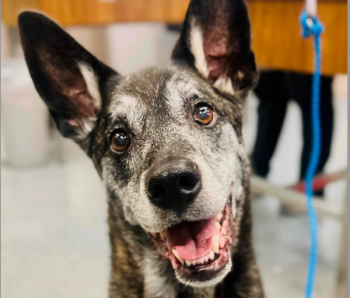
Treating deep-seated brain tumors in dogs
The arsenal of treatments available for patients with deep-seated glial tumors continues to grow.
The arsenal of treatments available for patients with deep-seated glial tumors continues to grow every year. And that's good news. One treatment to consider recommending to clients involves wide excision of these neoplasms.
When treating human patients with these types of tumors, neurosurgons struggle with critical considerations such as significant sensory or motor deficits that may result from the surgical procedure. For dogs, these long-term complications are less likely. It is important to keep in mind that a dog's brain differs significantly from that of people, and the alternative to more aggressive treatment is likely an early death either from the effects of the tumor itself or as a result of euthanasia.
The considerations highlighted here involve ablation of deep-seated glial tumors. Since the surgical rules for removing the most common neoplasm, the prefrontal meningioma, are less complicated, this discussion focuses on deep-brain neoplasms.
Differences between human and canine brain
If one believes the case for a designated and genetically well-defined language portion of the human brain, as eloquently outlined by Steven Pinker in the book Language Instinct, then one recognizes that the human brain needed to develop in a new way for everything to physically fit. We humans have exquisite and unique right and left brain anatomy. These assignments, with notable exceptions, develop early in life and commit brain areas to specific functions in an irreversible manner.
Sally Springer, in her book Left Brain, Right Brain, describes what we know about this lateralization. She writes about various experiments, including those involving primates and human stroke and surgical patients. Springer states that in subprimates the distinction between brain hemisphere function doesn't seem to exist; indeed, information is gathered and shared by both hemispheres. It makes sense that in order for language to fit into the already crowded and massively developing human brain, compromises might have to be made. While this is conjecture, it does lead to the first of two premises supporting surgical excision of the deep-seated glioma.
First, most of the literature states that these deep-seated tumors in dogs are inoperable. That determination is likely based on a lack of experience and concerns faced by our human neurosurgeon colleagues. Experimental ablation studies going back more than 100 years demonstrate that dogs are much less dependent on cortical function for daily activities. In my experience, the hemiparesis that occurs with large telencephalon ablation in surgical cases resolves dramatically within four to eight weeks after surgery. This dramatic resolution of signs is most likely the result of neural plasticity, where other portions of the brain (perhaps the remaining normal hemisphere) take over. This kind of recovery is known to be limited in humans. The first premise, then, is that dogs can regain an adequate amount of normal function after recovering from a significant surgical lesion to a single brain hemisphere. A large volume of older literature supports this.
The second premise encouraging us to consider surgical ablation of deep-seated glial tumors is that they rarely metastasize. These neoplasms almost always present as solitary, though large masses within the calvarium. Since metastasis is uncommon, a wide excision has the potential to be curative, even if the histopathologic description is "highly malignant." In fact, it can be surmised that the neoplasms are large at presentation because dogs can tolerate severe compressive and invasive damage before clinical signs become apparent. Therefore, since these neoplasms tend to be solitary and don't metastasize, a wide excision has the potential to be curative.
The surgical approaches to remove these tumors are complicated because the neoplastic tissue almost always looks exactly like—and is visually inseparable from—the surrounding normal brain parenchyma. The goal is to remove all of the neoplastic tissue whose margins are determined by landmarks obtained from either a computed tomography study or a magnetic resonance imaging (MRI) study. The results after removing large glial neoplasms have been mixed. It's difficult to demonstrate consistency because of variations between breeds, skull types, anatomical structures, tumor types and the array of follow-up strategies chosen. Tumor regrowth remains the greatest failure. However, the recovery of function from a very large telencephalic ablation is usually acceptable, provided the owner realizes the recovery process might take four to eight weeks.
Figure 1: A computed tomography scan of an 8-year-old spayed female boxer with an anaplastic glioma that was surgically removed.
Three cases make the point
An 8-year-old female spayed boxer whose tumor is demonstrated on a 1989 computed tomograpy image (Figure 1) had a wide surgical excision removing all of the neoplasm as determined by skull and brain landmarks. The dog made an acceptable recovery. The histopathologic diagnosis was anaplastic glioma. Two years later, the dog died of complications related to lymphosarcoma. On postmortem examination, no tumor cells were noted on histopathologic examination of the brain. The defect produced from the tumor ablation is visible in Figure 2.
Figure 2: A brain slice from the same boxer in Figure 1 showing the defect two years after the original surgery after it had died of complications from lymphosarcoma.
A 6-year-old spayed female cocker spaniel had the neoplasm demonstrated by MRI in Figure 3. A wide excision of the neoplasm was made, and the histopathologic diagnosis was oligodendroglioma. This tumor regrew and was removed three times, with an adequate recovery each time. Although tumor regrowth led to this dog's eventual demise, it was a comfortable companion for another 14 months.
Figure 3: An MRI of a female cocker spaniel. A surgical excision of this oligodendroglioma was repeated several times as the tumor regrew.
A 10-year-old male boxer whose tumor is shown in Figure 4 had a surgical ablation 10 months ago. The tumor was determined to be an astrocytoma. The quality of this dog's recovery is easily seen on our blog at
Figure 4: An MRI from a 10-year-old male boxer; this tumor was an astrocytoma. We are currently about one year from the original surgery.
Conclusion
It is not yet possible to determine when a wide ablation of deep-seated glial neoplasms will be completely successful, and it is necessary to consider the best time for and types of adjunctive therapy that may provide more successful outcomes. However, veterinarians should consider a wide excision of these neoplasms as a possible treatment. Alternatives are generally regarded as palliative and of limited success. With surgery, many of these patients will realize at least 12 months of good quality life, similar to what we can offer when treating other neoplasms.
Dr. Steinberg conceived of and opened one of the first totally referral-based private specialty hospitals in the United States in 1977. That hospital has evolved into the VCA Veterinary Referral Associates in Gaithersburg, Md., and he was appointed chief of staff in 2011.
Newsletter
From exam room tips to practice management insights, get trusted veterinary news delivered straight to your inbox—subscribe to dvm360.






